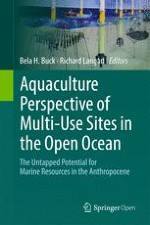Open Access 2017 | Open Access | Buch

Aquaculture Perspective of Multi-Use Sites in the Open Ocean
The Untapped Potential for Marine Resources in the Anthropocene
herausgegeben von: Bela H. Buck, Richard Langan
Open Access 2017 | Open Access | Buch

herausgegeben von: Bela H. Buck, Richard Langan
This book is open access under a CC BY 4.0 license.
This volume addresses the potential for combining large-scale marine aquaculture of macroalgae, molluscs, crustaceans, and finfish, with offshore structures, primarily those associated with energy production, such as wind turbines and oil-drilling platforms. The volume offers a comprehensive overview and includes chapters on policy, science, engineering, and economic aspects to make this concept a reality. The compilation of chapters authored by internationally recognized researchers across the globe addresses the theoretical and practical aspects of multi-use, and presents case studies of research, development, and demonstration-scale installations in the US and EU.